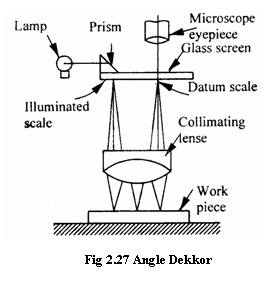Chapter: Mechanical : Metrology and Measurements : Linear and Angular Measurements
Angle Dekkor

ANGLE DEKKOR
This is also a type of
auto-collimator. There is an illuminated scale in the focal plane of the
collimating lens. This illuminated scale is projected as a parallel beam by the
collimating lens which after striking a reflector below the instrument is
refocused by the lens in the filed of view of the eyepiece. In the field of
view of microscope, there is another datum scale fixed across the center of
screen. The reflected image of the illuminated scale is received at right angle
to the fixed scale as shown in fig. Thus the changes in angular position of the
reflector in two planes are indicated by changes in the point of intersection
of the two scales. One division on the scale is calibrated to read 1 minute.

Uses of Angle Dekkor
(i) Measuring angle of a component
Angle dekkor is capable of measuring
small variations in angular setting i.e. determining angular tilt. Angle dekkor
is used in combination with angle gauge. First the angle gauge combination is
set up to the nearest known angle of the component. Now the angle dekkor is set
to zero reading on the illuminated scale. The angle gauge build up is then
removed and replaced by the component under test. Usually a straight edge being
used to ensure that there is no change in lateral positions. The new position
of the reflected scale with respect to the fixed scale gives the angular tilt
of the component from the set angle.
(ii)
Checking the slope angle of a V-block
Figure shows the set up for checking the sloping
angle of V block. Initially, a polished reflector or slip gauge is attached in
close contact with the work surface. By using angle gauge zero reading is
obtained in the angle dekkor. Then the angle may be calculated by comparing the
reading obtained from the angle dekkor and angle gauge.
(iii)
To measure the angle of cone or Taper gauge
Initially, the angle dekkor is set for the nominal
angle of cone by using angle gauge or sine bar. The cone is then placed in
position with its base resting on the surface plate. A slip gauge or reflector
is attached on the cone since no reflection can be obtained from the curved
surface. Any deviation from the set angle will be noted by the angle dekkor in
the eyepiece and indicated by the shifting of the image of illuminated scale.
Related Topics